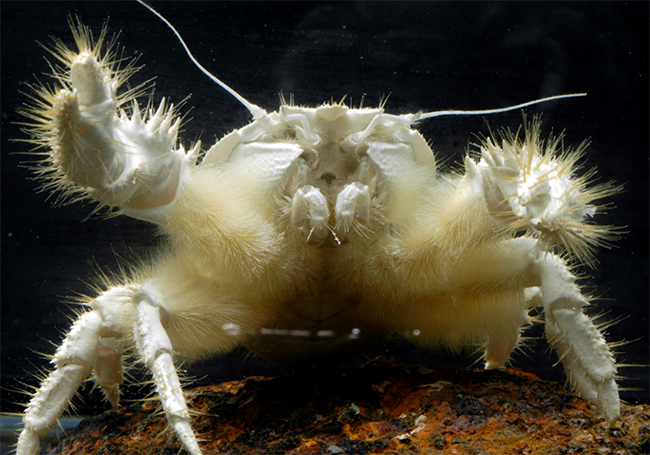Press Releases
October 14, 2014
JAMSTEC
Shinkaia crosnieri Obtains Nutrition
from Epibiotic Bacteria Found on Setae
~ Nutritional Relationship between Epibiotic Chemosynthetic Bacteria and Deep-sea Invertebrate Clearly Demonstrated ~
1.Overview
A research group led by Dr. Tomo-o Watsuji, Department of Subsurface Geobiological Analysis Research, Japan Agency for Marin-Earth Science and Technology Science (JAMSTEC: Asahiko Taira, President) successfully obtained direct evidence that the predominant deep-sea vent invertebrate Goemon-Koshiori-Ebi (Shinkaia Crosnieri) in the Okinawa Trough hydrothermal systems is nutritionally sustained by host-associated chemosynthetic bacteria.
While deep-sea vent invertebrates associated with epibiotic microbial community have been frequently discovered around the world, the nutritional relationship between epibionts and host animals has not been directly shown and its mechanism remains unclear. This study, which demonstrated that chemosynthetic bacterial epibionts are digested and absorbed by the host as a nutrition source, is expected to make significant contributions to elucidating the mechanism of nutritional transfer in ectosymbiosis between chemosynthetic bacteria and deep-sea invertebrates.
This result has been posted on the online ISME Journal on October 14 (11:00PM JST).
Title: Molecular evidence of digestion and absorption of epibiotic bacterial community by deep-sea crab Shinkaia crosnieri
Authors: Tomo-o Watsuji1*, Asami Yamamoto1, 2, Kaori Motoki1, 2, Kenji Ueda2, Emi Hada1, Yoshihiro Takaki1, Shinsuke Kawagucci1 and Ken Takai1
Affiliations: 1Department of Subsurface Geobiological Analysis and Research (D-SUGAR), Japan Agency for Marine-Earth Science and Technology (JAMSTEC)
2Life Science Research Center, College of Bioresource Sciences, Nihon University

Shinkaia crosnieri
Shinkaia crosnieri is a galatheid crab that predominantly dwells in deep-sea hydrothermal vent areas of Okinawa Trough. It has numerous hairs and a carapace length of 5 cm.

Figure 1: Optical and fluorescence microscopic observation of S. crosnieri setae. Optical and fluorescence microscopy of setae cut from a living S. crosnieri and of setae found in an S. crosnieri intestine is shown in the top panels (a, b) and in the bottom panels (c, d), respectively. Fluorescence microscopy shows the intrinsic fluorescence of setae (b, d). Optical microscopy shows the dense filamentous epibiotic populations and the typical morphological appearance of setae in a living individual (a) but the absence of epibionts on setae in the intestine (c). Capital S indicates a seta. Scale bars.50 µm (a–d).

Figure 2: Microscopic observation of intestine ingredients in living S. crosnieri individuals with and without dye-labelled epibiont tracer experiment.
Intestines and their ingredients obtained from a S. crosnieri individual (a)with crystal-violet-stained epibionts and (b) with unstained epibionts. Scale bars = 20 µm (a and b).

Figure 3: Microscopic observations of setae incubated with and without intestinal extract. Optical microscopy was performed to analyse setae dissected from a S. crosnieri individual before (a, c) and after (b, d) incubation with (a, b) and without (c, d) intestinal extract.
Capital S indicates a seta. Scale bars.50 µm (a and b).
| Table 1: Activity of digestive enzymes in the intestinal extract. | |||
| α-Amylase | Lipase | Protease | |
| Specific activity (U/mg protein) |
22.3 | 2.2 | 351 |

Figure 5: Time course of consumption of sulphide and methane by homogenates of S. crosnieri intestine and setae with epibionts. The concentrations of sulphide (a) and methane (b) were examined at the indicated intervals in the absence of the homogenate sample (■) and in the presence of homogenized setae with epibionts (△) and homogenized intestines (◯).
Table 2: Stable carbon isotope compositions of different tissues of a living Shinkaia crosnieri individual and a dissected intestine before and after 13C-labelled bicarbonate tracer experiments

†Values were measured in triplicate and were expressed as mean ± standard deviation.
Shinkaia crosnieri during “eating”
Shinkaia crosnieri at Great Depths (photo taken during Hyper Dolphin cruise)
Contacts:
- (For this study)
- Tomo-o Watsuji, Scientist, Department of Subsurface Geobiological Analysis Research
- (For press release)
- Kazushige Kikuchi, Manager, Press Office, Public Relations